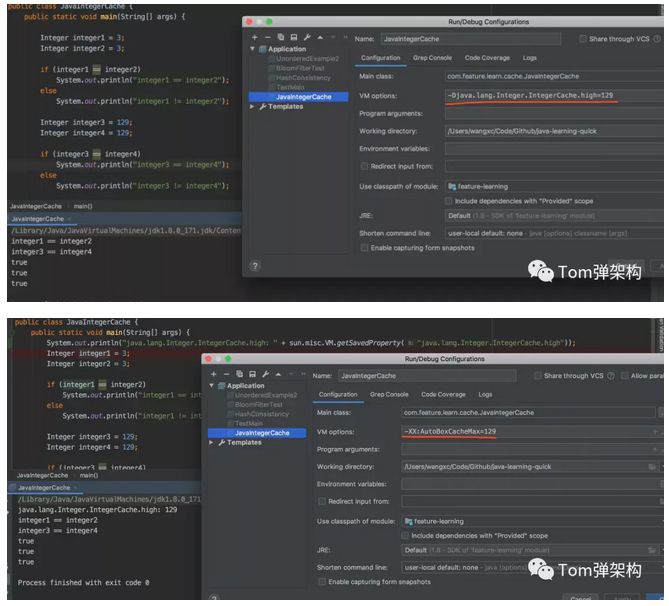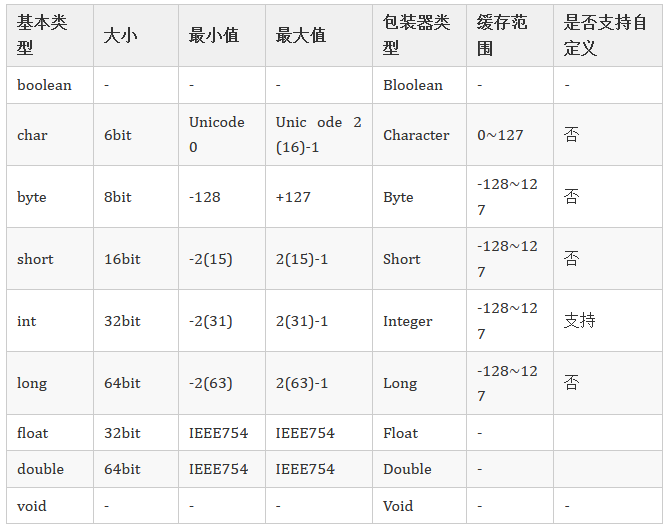一个疏忽损失惨重!就因为把int改成Integer,第2天被辞了
1 故事背景
一个程序员就因为改了生产环境上的一个方法参数,把int型改成了Integer类型,因为涉及到钱,结果上线之后公司损失惨重,程序员被辞退了。信不信继续往下看。先来看一段代码:
public static void main(String[] args) {
Integer a = Integer.valueOf(100);
Integer b = 100;
Integer c = Integer.valueOf(129);
Integer d = 129;
System.out.println("a==b:" + (a==b));
System.out.println("c==d:" + (c==d));
}
大家猜它的运行结果是什么?在运行完程序后,我们才发现有些不对,得到了一个意想不到的运行结果,如下图所示。

看到这个运行结果,有人就一定会问,为什么是这样?之所以得到这样的结果,是因为Integer用到的享元模式。来看Integer的源码。
public final class Integer extends Number implements Comparable<Integer> {
...
public static Integer valueOf(int i) {
if (i >= IntegerCache.low && i <= IntegerCache.high)
return IntegerCache.cache[i + (-IntegerCache.low)];
return new Integer(i);
}
...
}
再继续进入到IntegerCache的源码来看low和high的值:
private static class IntegerCache {
// 最小值
static final int low = -128;
// 最大值,支持自定义
static final int high;
// 缓存数组
static final Integer cache[];
static {
// 最大值可以通过属性配置来改变
int h = 127;
String integerCacheHighPropValue =
sun.misc.VM.getSavedProperty("java.lang.Integer.IntegerCache.high");
// 如果设置了对应的属性,则使用该值
if (integerCacheHighPropValue != null) {
try {
int i = parseInt(integerCacheHighPropValue);
i = Math.max(i, 127);
// 最大数组大小为Integer.MAX_VALUE
h = Math.min(i, Integer.MAX_VALUE - (-low) -1);
} catch( NumberFormatException nfe) {
// If the property cannot be parsed into an int, ignore it.
}
}
high = h;
cache = new Integer[(high - low) + 1];
int j = low;
// 将low-high范围内的值全部实例化并存入数组中当缓存使用
for(int k = 0; k < cache.length; k++)
cache[k] = new Integer(j++);
// range [-128, 127] must be interned (JLS7 5.1.7)
assert IntegerCache.high >= 127;
}
private IntegerCache() {}
}
由上可知,Integer源码中的valueOf()方法做了一个条件判断,如果目标值在-128 - 127,则直接从缓存中取值,否则新建对象。其实,Integer第一次使用的时候就会初始化缓存,其中范围最小值为-128,最大值默认是127。接着会把low至high中所有的数据初始化存入数据中,默认就是将-128 - 127总共256个数循环实例化存入cache数组中。准确的说应该是将这256个对象在内存中的地址存进数组中。这里又有人会问了,那为什么默认是-128 - 127,怎么不是-200 - 200或者是其他值呢?那JDK为何要这样做呢?
在Java API 中是这样解释的:
Returns an Integer instance representing the specified int value. If a new Integer instance is not required, this method should generally be used in preference to the constructor Integer(int), as this method is likely to yield significantly better space and time performance by caching frequently requested values. This method will always cache values in the range -128 to 127, inclusive, and may cache other values outside of this range
大致意思是:
128~127的数据在int范围内是使用最频繁的,为了减少频繁创建对象带来的内存消耗,这里其实是用到了享元模式,以提高空间和时间性能。
JDK增加了这一默认的范围并不是不可变,我们在使用前可以通过设置-Djava.lang.Integer.IntegerCache.high=xxx或者设置-XX:AutoBoxCacheMax=xxx来修改缓存范围,如下图:

后来,我又找到一个比较靠谱的解释:
实际上,在Java 5中首次引入此功能时,范围固定为-127到+127。后来在Java 6中,范围的最大值映射到java.lang.Integer.IntegerCache.high,VM参数允许我们设置高位数。根据我们的应用用例,它可以灵活地调整性能。应该从-127到127选择这个数字范围的原因应该是什么。这被认为是广泛使用的整数范围。在程序中首次使用Integer必须花费额外的时间来缓存实例。
Java Language Specification 的原文解释如下:
Ideally, boxing a given primitive value p, would always yield an identical reference. In practice, this may not be feasible using existing implementation techniques. The rules above are a pragmatic compromise. The final clause above requires that certain common values always be boxed into indistinguishable objects. The implementation may cache these, lazily or eagerly. For other values, this formulation disallows any assumptions about the identity of the boxed values on the programmer's part. This would allow (but not require) sharing of some or all of these references. This ensures that in most common cases, the behavior will be the desired one, without imposing an undue performance penalty, especially on small devices. Less memory-limited implementations might, for example, cache all char and short values, as well as int and long values in the range of -32K to +32K.
2 关于Integer和int的比较
\1) 由于Integer变量实际上是对一个Integer对象的引用,所以两个通过new生成的Integer变量永远是不相等的(因为new生成的是两个对象,其内存地址不同)。
Integer i = new Integer(100);
Integer j = new Integer(100);
System.out.print(i == j); //false
\2) Integer变量和int变量比较时,只要两个变量的值是向等的,则结果为true(因为包装类Integer和基本数据类型int比较时,java会自动拆包装为int,然后进行比较,实际上就变为两个int变量的比较)
Integer i = new Integer(100);
int j = 100;
System.out.print(i == j); //true
\3) 非new生成的Integer变量和new Integer()生成的变量比较时,结果为false。(因为 ①当变量值在-128 - 127之间时,非new生成的Integer变量指向的是java常量池中的对象,而new Integer()生成的变量指向堆中新建的对象,两者在内存中的地址不同;②当变量值在-128 - 127之间时,非new生成Integer变量时,java API中最终会按照new Integer(i)进行处理(参考下面第4条),最终两个Interger的地址同样是不相同的)
Integer i = new Integer(100);
Integer j = 100;
System.out.print(i == j); //false
\4) 对于两个非new生成的Integer对象,进行比较时,如果两个变量的值在区间-128到127之间,则比较结果为true,如果两个变量的值不在此区间,则比较结果为false
3 扩展知识
在JDK中,这样的应用不止int,以下包装类型也都应用了享元模式,对数值做了缓存,只是缓存的范围不一样,具体如下表所示:

大家觉得这个锅背得值不值?
4 使用享元模式实现数据库连接池
再举个例子,我们经常使用的数据库连接池,因为使用Connection对象时主要性能消耗在建立连接和关闭连接的时候,为了提高Connection对象在调用时的性能,将Connection对象在调用前创建好并缓存起来,在用的时候直接从缓存中取值,用完后再放回去,达到资源重复利用的目的,代码如下。
public class ConnectionPool {
private Vector<Connection> pool;
private String url = "jdbc:mysql://localhost:3306/test";
private String username = "root";
private String password = "root";
private String driverClassName = "com.mysql.jdbc.Driver";
private int poolSize = 100;
public ConnectionPool() {
pool = new Vector<Connection>(poolSize);
try{
Class.forName(driverClassName);
for (int i = 0; i < poolSize; i++) {
Connection conn = DriverManager.getConnection(url,username,password);
pool.add(conn);
}
}catch (Exception e){
e.printStackTrace();
}
}
public synchronized Connection getConnection(){
if(pool.size() > 0){
Connection conn = pool.get(0);
pool.remove(conn);
return conn;
}
return null;
}
public synchronized void release(Connection conn){
pool.add(conn);
}
}
这样的连接池,普遍应用于开源框架,可以有效提升底层的运行性能。
一个疏忽损失惨重!就因为把int改成Integer,第2天被辞了的更多相关文章
- 就因为把int改成Integer,第2天被辞了
本文节选自<设计模式就该这样学>之享元模式(Flyweight Pattern) 1 故事背景 一个程序员就因为改了生产环境上的一个方法参数,把int型改成了Integer类型,因为涉及到 ...
- 今天做一个winform,想直接把窗体改成输出类库,其他地方直接调结果总提示不能注册组件,回来调度,可以,总结,windows还是直接用新建的类型项目,改容易出错
如题, 对于winform程序,还是新建一个类库,这样,在类库里面可以添加窗体.这样可以提供其他程序集来调用里面的窗体
- String.valueOf(int i)和Integer.toString(int i)有什么区别?
以下是2个人的回答,我是从百度上复制下来的,做个笔记,以后方便看 String.valueOf()它可以将JAVA基本类型(int,double,boolean等)和对象(Object)转换成Stri ...
- arm指令bne.w改成b,即无条件跳转
近期逆向一个程序,需要把bne.w改成b,无条件跳转.由于ios逆向不像pc上,可以在od里直接改汇编指令,这篇文章给了我很大的帮助.通过memory write 修改后,验证可行后,再用ultrae ...
- 转:JAVA里面的int类型 和Integer类型,有什么不一样
JAVA里面的int类型 和Integer类型,有什么不一样 原文链接:http://blog.csdn.net/wuxinliulei/article/details/11099565 java.l ...
- 关于将汉语拼音字母“ü”改成“v”的设想和建议
http://bbs.tianya.cn/post-free-1667253-1.shtml?_t=t -- 徐州工业职业技术学院 孙生强 <汉语拼音方案>为中国人的语言文字学习带来极大方 ...
- JAVA里面的int类型 和Integer类型,有什么不一样
JAVA里面的int类型 和Integer类型,有什么不一样 原创 2013年09月04日 23:15:11 标签: java / 2120 编辑 删除 JAVA里面的int类型 和Integer类型 ...
- LigerUI一个前台框架增、删、改asp.net代码
LigerUI一个前台框架增.删.改asp.net代码的实现 先上代码:前台代码 <!DOCTYPE html PUBLIC "-//W3C//DTD XHTML 1.0 Tran ...
- Java笔试题:给定一个ReadOnlyClass的对象roc,能否把这个对象的age值改成30?
在Java笔试面试中,经常会遇到代码题,今天我们就来看一则Java代码笔试题. 有如下代码: Class ReadOnlyClass { private Integer age=20; public ...
随机推荐
- Appium自动化测试时为什么要自己封装find方法
官方的find_element方法不能很好地处理异常,所以自行封装,以智能化处理各种异常
- P5445-[APIO2019]路灯【set,树状数组套线段树】
正题 题目链接:https://www.luogu.com.cn/problem/P5445 题目大意 \(n+1\)个点,\(i\)和\(i+1\)个点之间有一条边,\(q\)个操作 断开/连接第\ ...
- Java MD5和SHA256等常用加密算法
前言 我们在做java项目开发的时候,在前后端接口分离模式下,接口信息需要加密处理,做签名认证,还有在用户登录信息密码等也都需要数据加密.信息加密是现在几乎所有项目都需要用到的技术,身份认证.单点登陆 ...
- GoLang设计模式08 - 命令模式
命令模式是一种行为型模式.它建议将请求封装为一个独立的对象.在这个对象里包含请求相关的全部信息,因此可以将其独立执行. 在命令模式中有如下基础组件: Receiver:唯一包含业务逻辑的类,命令对象会 ...
- SpringBoot-使用异步
SpringBoot提供了异步的支持,上手使用十分的简单,只需要开启一些注解支持,配置一些配置文件即可! 编写方法,假装正在处理数据,使用线程设置一些延时,模拟同步等待的情况: service: @S ...
- Python 面向对象笔记
Python 面向对象课程笔记 前言 Python 面向对象 正文 基本概念 什么是对象: 万物皆对象 对象是具体物体: 拥有属性 拥有行为 封装零散为整体 OOP(Object Oriented P ...
- (翻译)领域驱动设计实现-Implementing Domain Driven Design
简介 Implementing Domain Driven Design 领域驱动设计实现 A practical guide for implementing the Domain Driven D ...
- Linux信号处理编程
01. 学习目标 了解信号中的基本概念 熟练使用信号相关的函数 了解内核中的阻塞信号集和未决信号集作用 熟悉信号集操作相关函数 熟练使用信号捕捉函数signal 熟练使用信号捕捉函数sigaction ...
- 【c++ Prime 学习笔记】第16章 模板与泛型编程
面向对象编程(OOP)和泛型编程(GP)都能处理在编写程序时类型未知的情况 OOP能处理运行时获取类型的情况 GP能处理编译期可获取类型的情况 标准库的容器.迭代器.算法都是泛型编程 编写泛型程序时独 ...
- 改善深层神经网络-week1编程题(Regularization)
Regularization Deep Learning models have so much flexibility and capacity that overfitting can be a ...
